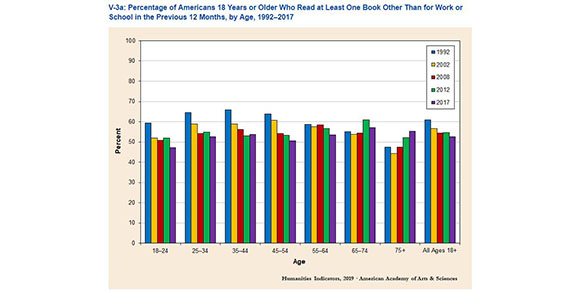
The American Academy of Arts and Sciences recently updated their Humanities Indicators with information gathered during the National Endowment of the Arts’ Survey of Public Participation in the Arts. These updates focused on capturing book-reading behaviors of American adults in 2017.
The survey found that a little over half (53%) of American adults had read at least one book for pleasure in the past 12 months, the lowest level since the survey began in 1982. Reading rates declined the most among adults aged 55 and younger. However, respondents’ participation in book clubs and reading groups increased to 1 in 20 (5%, up from 3.5% in 2012).
American adults spent less of their leisure time reading in 2017 than in previous years. Respondents reported reading, on average, just under 17 minutes per day, 5 minutes less than in 2003. Reading time declined at every education level, with the largest decline occurring among those with advanced college degrees, falling from 39 minutes per day in 2003 to 27 minutes in 2017. Time spent reading also declined among every age group, except for the two youngest – 15-19 and 20-24 year olds. Respondents spent an average of 2 hours and 46 minutes watching television and 28 minutes using computers for leisure per day.
The survey also asked what kinds of books Americans are reading. Poetry readership increased among younger readers (18-24 years old), with the rate rising from 8.2% in 2012 to 17.5% in 2017. The types of books respondents read also differed by gender. Half of women (50%) reported reading a novel or short story in the past year compared to a third of men (33%). Conversely, about half of men (49%) read a history book, compared to a little less than 2 in 5 women (37%).
The full list of updates can be found here. The new updates are explored in three groups: Book Reading Behavior, Time Spent Reading, and Book Reading: Topics.
Note: This post is part of our series, “The LRS Number.” In this series, we highlight statistics that help tell the story of the 21st-century library.